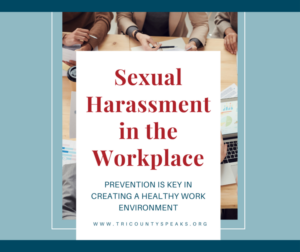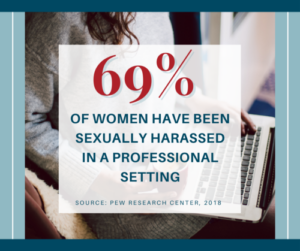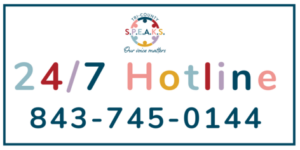Sexual harassment is and continues to be a contributing factor in staff turnover. While many companies understand the economic burden that comes with re-training employees, little take the time to explore the importance of addressing sexual harassment and its consequences in the workplace.
In 2017, the #MeToo movement brought to light the experiences of victims and survivors around the county that may have been negatively impacted by sexual violence and workplace harassment. The following year, there was a 14% increase of sexual harassment claims with the EEOC in FY 2018. As the media shared countless stories of violence, victims felt empowered to file a complaint and seek support within their organizations. In 2018, Pew Research Center shares 69% of women have been sexually harassed in a professional setting – a shocking number that reveals harassment is a lot more common than one may realize.
The EEOC defines sexual harassment as unwelcome sexual advances, requests for sexual favors, and other verbal or physical harassment of a sexual nature. Harassment is not always sexual in nature but, can include offensive statements regarding a person’s sex or gender. It’s important to remember that the victim or harasser can be any gender and of the same sex.
Although the law doesn’t prohibit simple teasing, offhand comments or isolated incidents, harassment is illegal when it is so frequent or severe that it creates a hostile or offensive work environment or when it results in an adverse employment decision (such as the victim being fired or demoted).
The harasser can be the victim’s supervisor or another person in a position of power, a co-worker, or a client or customer.
Shockingly, 72% of workplace sexual harassment victims don’t report the harassment (Career Builder, 2018). When it comes to reporting, one may choose to not report for many reasons including fear of retaliation or lack of support from management.. When creating supportive and healthy workplace environments, consider asking yourself how your organization prevents harassment in the workplace, how does the organization communicate with employees of their reporting options, and what policies are set in place to support and protect victims.
Harvard Business Review shares 98% of U.S. organizations have a sexual harassment policy (2016). While having a policy is a great start, prevention of harassment also looks like defining sexual harassment, giving examples of inappropriate conduct, and sharing consequences with a zero-tolerance approach. Other prevention strategies could be offering trainings that allow employees to become aware of their own behaviors, improve their ability to detect workplace harassment and inappropriate behaviors, and learn skills to equip employees to prevent incidents. As sexual violence prevention experts in the community, Tri-County S.P.E.A.K.S. offers trainings and technical assistance to the community on violence prevention and survivor support. We invite you to learn more by visiting www.tricountyspeaks.org.
Tri-County S.P.E.A.K.S. is seeking donations from local businesses to help prevent sexual harassment and violence through trainings and outreach. Help us reach our goal of raising $10,000 to help target our efforts in the Charleston, Berkeley, and Dorchester Counties by making a tax-deductible donation at www.tricountyspeaks.org/donate.
Tri-County S.P.E.A.K.S. is a 501c3 non-profit. All donations go towards providing essential services to survivors and education and prevention initiatives to community organizations and businesses.




